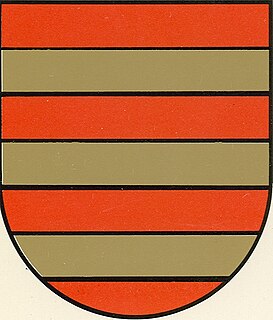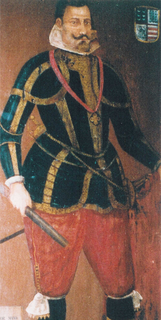The known history of Mauritius begins with its discovery by Arabs, followed by Europeans and its appearance on maps in the early 16th century. Mauritius was successively colonized by the Dutch, the French and the British, and became independent in 1968.

Marshal João Baptista Mascarenhas de Morais was a Brazilian army officer and commander of the Brazilian Expeditionary Force in the Second World War. He was ranked Field Marshal and was the last active Brazilian marshal.

Duke of Lafões was a Portuguese title of nobility created under the decree of February 17, 1718, of King John V of Portugal and granted to his nephew, Dom Pedro Henrique de Bragança, son of the Infante Miguel de Bragança, an illegitimate son of King Peter II of Portugal and Anne Armande Pastre de Verger, though Pedro's mother, Luisa Casimira de Sousa Nassau e Ligne was the first to use this title.The title was later passed on to his brother, João Carlos de Bragança e Ligne de Sousa Tavares Mascarenhas da Silva, the most famous Duke of this title.

Francisco Barreto was a Portuguese soldier and explorer. An officer in Morocco during his early life, Barreto sailed to Portuguese India and was eventually appointed viceroy of the colony. After his return to Lisbon, he was tasked with an expedition to southeast Africa in search of legendary gold mines. Barreto died in what is now Mozambique, having never reached the mines.
Count of Santa Cruz was a Portuguese title of nobility created by a royal decree of King Philip II of Portugal, also known as Philip III of Spain, dated from October 3, 1593, and granted to Francisco de Mascarenhas (1530-1608), nephew of Dom Pedro de Mascarenhas, 6th Viceroy of Portuguese India.

Count of Torre was a Portuguese title of nobility created by a royal decree, dated from July 26, 1638, by King Philip II of Portugal, and granted to Dom Fernando de Mascarenhas, Lord of Rosmaninhal.
D. António de Almeida Soares de Portugal, 1st Count and 1st Marquess of Lavradio, 4th Count of Avintes, Governor General of Angola and Viceroy of Brazil. Born in Lisbon, Portugal on 1 May 1701; died in São Salvador da Bahia, Brazil on 4 July 1760. The first Marquess of Lavradio was a prominent Portuguese statesman and the head of an established noble family.
Domingos António da Silva, known as Mascarenhas, was an Angolan footballer who played as a forward.
António Mascarenhas may refer to:
The Action of 12–17 January 1640 was a naval battle between a Dutch fleet and a combined Spanish-Portuguese fleet during the Eighty Years' War. The battle took place on the Brazilian coast off Pernambuco and was an attempt by a fleet consisting of approximately eighty vessels transporting about 5,000 soldiers under the command of Portuguese Admiral Fernando de Mascarenhas to land reinforcements to bolster the Portuguese militia besieging the city of Recife. On 12 January this fleet was intercepted by a Dutch task force of about forty ships commanded by Willem Loos. The ensuing battle lasted with occasional breaks until the evening of 17 January, when the Spanish and Portuguese fleet retreated and sailed away to the north.
Fernando de Mascarenhas, the first Count of the Tower, was a military and colonial administrator and held the position of Portuguese governor-general of Brazil from January 20 of 1639 to November 20, 1639, appointed by King Philip III.
Events from the year 1584 in India.
Francisco de Meneses was the 3rd Governor of Portuguese Ceylon. de Meneses was appointed in 1613 under Philip II of Portugal, he was Governor until 1614. He was succeeded by Manuel Mascarenhas Homem.
Manuel Mascarenhas Homem was the Governor of Portuguese Ceylon. Homem was appointed in 1614 under Philip II of Portugal as the governor, serving until 1616 and being succeeded by Nuno Álvares Pereira.
Constantino de Sá de Noronha was the 6th and 8th Governor of Portuguese Ceylon. De Noronha was first appointed in 1618 under Philip II of Portugal, he was Governor until 1622 and then in 1623 until 1630. He died in the Battle of Randeniwela, refusing to abandon his troops in the face of total anhialation. He was succeeded by Jorge de Albuquerque and Filipe Mascarenhas respectively.
Diogo de Melo de Castro was the 11th & 13th Governor of Portuguese Ceylon. De Melo was first appointed in 1633 under Philip III of Portugal, he was Governor until 1635 and then in 1636 until 1638. He died in the Battle of Gannoruwa and was succeeded by Jorge de Almeida and António Mascarenhas respectively.
Domingos Correia Arouca was a Portuguese general, administrator and colonial governor of Cape Verde from 1835 to 1837, he was also a Portuguese politician and freemason.

Manuel Mascarenhas Homem was the Governor of Portuguese Ceylon and viceroy of Portuguese india.

General Vasco Mascarenhas, 1st Count of Óbedos, OC, was a Portuguese nobleman and colonial governor, who was Governor General of Brazil, Viceroy of Brazil and Viceroy of India.






